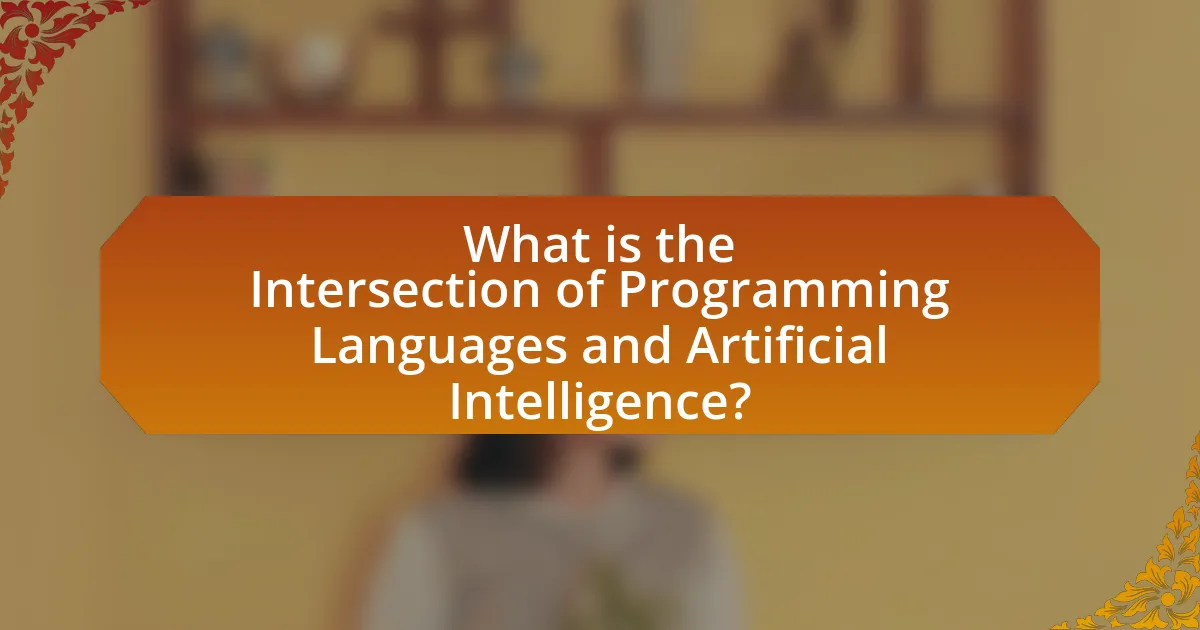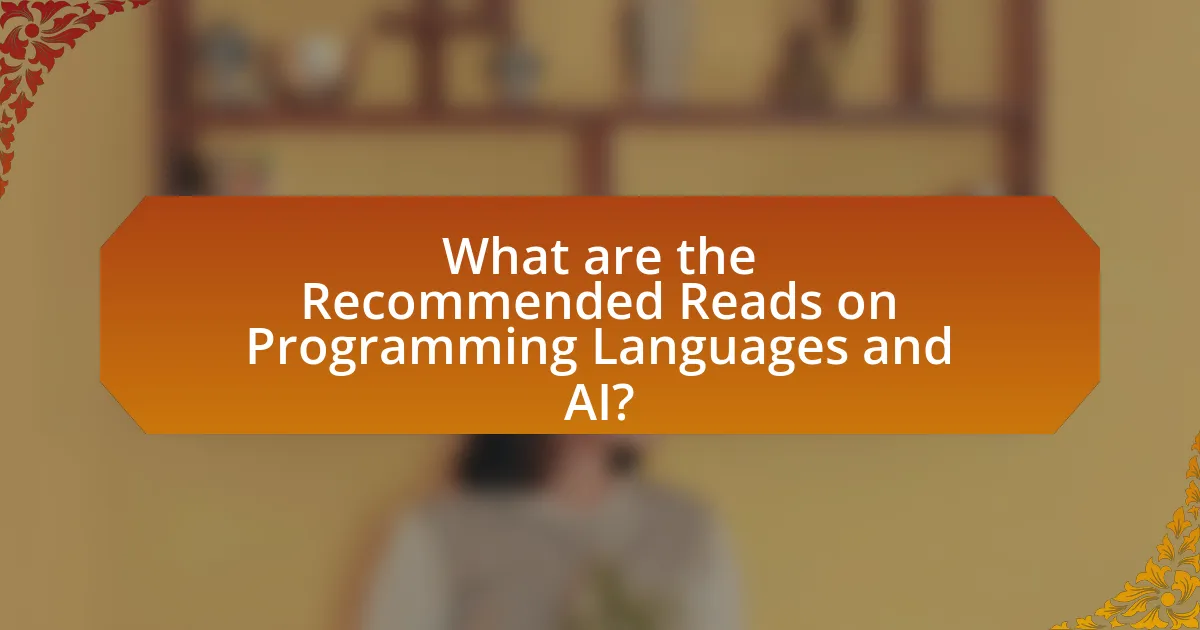The article focuses on the intersection of programming languages and artificial intelligence, highlighting how specific programming languages facilitate the development and implementation of AI algorithms and models. It discusses key programming languages used in AI, such as Python, R, and Java, and their impact on AI performance through efficiency and available libraries. Additionally, the article emphasizes the importance of understanding this intersection for developers, outlining necessary skills and providing recommended readings that cover foundational knowledge and advanced resources in programming for AI. Practical tips for applying insights from these resources and common pitfalls to avoid while learning about AI and programming are also addressed.

What is the Intersection of Programming Languages and Artificial Intelligence?
The intersection of programming languages and artificial intelligence lies in the ability of programming languages to facilitate the development and implementation of AI algorithms and models. Programming languages such as Python, R, and Java are widely used in AI due to their libraries and frameworks that support machine learning, data analysis, and neural networks. For instance, Python’s TensorFlow and PyTorch libraries are essential for building deep learning models, demonstrating how specific programming languages enable the practical application of AI concepts.
How do programming languages facilitate artificial intelligence development?
Programming languages facilitate artificial intelligence development by providing the necessary tools and frameworks for implementing algorithms and managing data efficiently. For instance, languages like Python offer extensive libraries such as TensorFlow and PyTorch, which simplify the process of building and training machine learning models. Additionally, languages like R are specifically designed for statistical analysis, making them ideal for data-driven AI applications. The versatility and community support of these languages enable rapid prototyping and experimentation, which are crucial in AI research and development.
What are the key programming languages used in AI?
The key programming languages used in AI are Python, R, Java, C++, and Julia. Python is the most popular due to its simplicity and extensive libraries like TensorFlow and PyTorch, which facilitate machine learning and deep learning. R is favored for statistical analysis and data visualization, making it useful in data-driven AI projects. Java is known for its portability and scalability, often used in large-scale systems. C++ offers performance advantages in resource-intensive applications, while Julia is gaining traction for its speed and ease of use in numerical and scientific computing. These languages are widely adopted in the AI community, supported by a wealth of frameworks and tools that enhance their capabilities.
How do different programming languages impact AI performance?
Different programming languages significantly impact AI performance through their efficiency, libraries, and community support. For instance, Python is widely favored for AI development due to its extensive libraries like TensorFlow and PyTorch, which streamline machine learning tasks. In contrast, languages like C++ offer faster execution speeds, making them suitable for performance-critical applications, such as real-time systems. Research indicates that the choice of programming language can affect the speed of algorithm implementation and the ease of integrating complex models, with studies showing that Python can reduce development time by up to 50% compared to lower-level languages. Thus, the programming language selected directly influences both the development process and the operational efficiency of AI systems.
Why is understanding this intersection important for developers?
Understanding the intersection of programming languages and artificial intelligence is crucial for developers because it enables them to create more efficient, effective, and innovative AI solutions. This knowledge allows developers to select the most suitable programming languages and frameworks that optimize AI algorithms, enhancing performance and scalability. For instance, Python is widely used in AI due to its extensive libraries like TensorFlow and PyTorch, which facilitate machine learning development. By grasping this intersection, developers can leverage the strengths of various programming languages to implement advanced AI techniques, ultimately leading to better product outcomes and competitive advantages in the tech industry.
What skills do developers need to work at this intersection?
Developers need a combination of programming proficiency, understanding of artificial intelligence concepts, and data analysis skills to work at the intersection of programming languages and artificial intelligence. Proficiency in languages such as Python, R, or Java is essential, as these are commonly used in AI development. Understanding machine learning algorithms, neural networks, and natural language processing is crucial for implementing AI solutions. Additionally, skills in data manipulation and analysis, often using libraries like Pandas or NumPy, are necessary to handle and interpret data effectively. These skills enable developers to create robust AI applications that leverage programming languages effectively.
How can knowledge of programming languages enhance AI projects?
Knowledge of programming languages enhances AI projects by enabling developers to implement algorithms, manipulate data, and optimize performance effectively. Proficiency in languages such as Python, R, and Java allows for the utilization of extensive libraries and frameworks specifically designed for AI, such as TensorFlow and PyTorch. These tools facilitate the development of machine learning models and streamline data processing tasks. For instance, Python’s simplicity and rich ecosystem make it the preferred choice for AI research and development, as evidenced by its widespread use in academic papers and industry applications.

What are the Recommended Reads on Programming Languages and AI?
Recommended reads on programming languages and AI include “Artificial Intelligence: A Modern Approach” by Stuart Russell and Peter Norvig, which provides foundational knowledge in AI concepts and programming. Another essential read is “Deep Learning” by Ian Goodfellow, Yoshua Bengio, and Aaron Courville, which covers the programming techniques used in deep learning applications. Additionally, “Programming in Haskell” by Graham Hutton offers insights into functional programming, which is increasingly relevant in AI development. These texts are widely recognized in the field and are used in academic courses, reinforcing their credibility and importance in understanding the intersection of programming languages and AI.
Which books provide foundational knowledge in programming for AI?
“Artificial Intelligence: A Modern Approach” by Stuart Russell and Peter Norvig provides foundational knowledge in programming for AI. This book is widely regarded as a comprehensive resource, covering essential concepts in AI, algorithms, and programming techniques. Additionally, “Python Machine Learning” by Sebastian Raschka and Vahid Mirjalili offers practical insights into implementing machine learning algorithms using Python, a key programming language in AI development. Both books are frequently used in academic settings and are recommended for anyone seeking to understand the programming aspects of artificial intelligence.
What are the top introductory books on programming languages?
The top introductory books on programming languages include “Programming Language Pragmatics” by Michael L. Scott, “Concepts of Programming Languages” by Robert W. Sebesta, and “Programming Languages: Principles and Paradigms” by Allen B. Tucker and Robert E. Noonan. These books provide foundational knowledge on programming language design, implementation, and usage. “Programming Language Pragmatics” is widely recognized for its comprehensive coverage of language concepts and practical applications, making it a staple in computer science education. “Concepts of Programming Languages” offers insights into the evolution of programming languages and their underlying principles, while “Programming Languages: Principles and Paradigms” explores various programming paradigms, enhancing understanding of language features and their applications.
How do these books relate to AI concepts?
These books relate to AI concepts by providing foundational knowledge and practical applications of programming languages essential for developing AI systems. For instance, texts that focus on Python illustrate its role in machine learning and data analysis, which are core components of AI. Additionally, books that cover languages like R emphasize statistical modeling and data manipulation, crucial for AI algorithms. The integration of programming languages with AI concepts is evidenced by the widespread use of these languages in AI research and development, as seen in numerous academic papers and industry applications.
What advanced resources are available for experienced developers?
Advanced resources for experienced developers include specialized books, online courses, and research papers that focus on the intersection of programming languages and artificial intelligence. Notable books such as “Deep Learning” by Ian Goodfellow, Yoshua Bengio, and Aaron Courville provide in-depth knowledge on AI concepts and techniques. Online platforms like Coursera and edX offer advanced courses on machine learning and AI, often created by top universities. Additionally, research papers from conferences like NeurIPS and ICML present cutting-edge findings and methodologies in AI, making them essential resources for developers looking to deepen their expertise.
Which books focus on specific programming languages in AI?
Books that focus on specific programming languages in AI include “Python Machine Learning” by Sebastian Raschka, which emphasizes Python’s role in machine learning applications, and “Deep Learning with R” by François Chollet and J.J. Allaire, which showcases R for deep learning tasks. Additionally, “Hands-On Machine Learning with Scikit-Learn, Keras, and TensorFlow” by Aurélien Géron highlights Python libraries for practical machine learning implementations. These books provide concrete examples and applications of programming languages in the context of artificial intelligence, demonstrating their relevance and utility in the field.
How do these advanced resources address current AI challenges?
Advanced resources address current AI challenges by providing updated methodologies, frameworks, and tools that enhance the efficiency and effectiveness of AI systems. For instance, programming languages like Python and R offer extensive libraries and frameworks such as TensorFlow and PyTorch, which facilitate the development of complex AI models. These resources enable researchers and developers to implement state-of-the-art algorithms, optimize performance, and streamline the deployment of AI applications. Furthermore, studies indicate that the integration of advanced programming techniques can significantly reduce the time required for model training and improve accuracy, thereby directly addressing challenges related to scalability and performance in AI.

How can readers apply insights from these recommended reads?
Readers can apply insights from these recommended reads by integrating the programming concepts and AI principles discussed into their own projects. For instance, understanding the nuances of different programming languages can enhance coding efficiency and adaptability in AI applications. Research indicates that familiarity with multiple programming languages, such as Python and R, can significantly improve a developer’s ability to implement machine learning algorithms effectively, as evidenced by a study from the Journal of Machine Learning Research, which highlights the correlation between language proficiency and project success rates. By actively engaging with the material, readers can refine their skills and apply theoretical knowledge to practical scenarios, thereby enhancing their contributions to the field of artificial intelligence.
What practical tips can enhance learning from these resources?
To enhance learning from resources on the intersection of programming languages and artificial intelligence, actively engage with the material by taking notes and summarizing key concepts. This method reinforces understanding and retention. Research indicates that active learning techniques, such as summarization, can improve comprehension and memory recall, as shown in studies by Dunlosky et al. (2013) in “Improving Students’ Learning with Effective Learning Techniques.” Additionally, applying concepts through practical projects or coding exercises solidifies knowledge, as hands-on experience is crucial in programming and AI.
How can readers implement knowledge from books into real-world projects?
Readers can implement knowledge from books into real-world projects by actively applying concepts learned through hands-on practice and experimentation. For instance, after studying a programming language or AI concept, readers should create small projects that utilize these principles, such as building a simple application or developing a machine learning model. This approach reinforces understanding and allows for practical experience. Research indicates that experiential learning significantly enhances retention and application of knowledge, as demonstrated in studies by Kolb (1984) on experiential learning theory, which emphasizes the importance of applying theoretical knowledge in practical settings.
What common pitfalls should readers avoid when learning about AI and programming?
Readers should avoid the pitfall of underestimating the importance of foundational knowledge in programming and AI concepts. Many learners jump directly into complex frameworks or tools without a solid understanding of basic programming principles, algorithms, and data structures, which are essential for effective problem-solving in AI. Research indicates that a strong grasp of these fundamentals significantly enhances the ability to understand and implement AI techniques, as evidenced by studies showing that students with foundational programming skills perform better in advanced AI courses. Additionally, learners often neglect to practice coding regularly, which is crucial for reinforcing skills and understanding.


